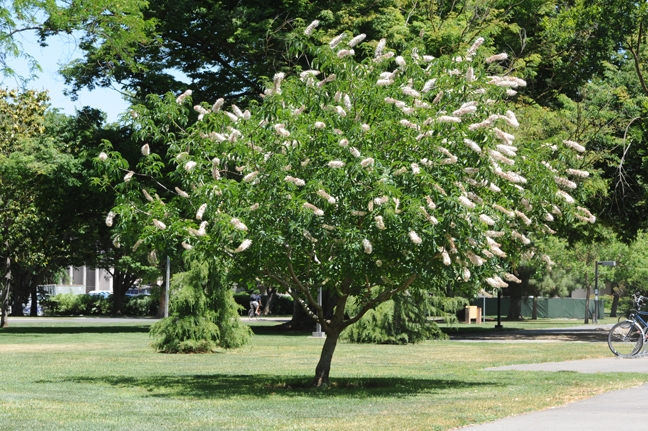Beekeepers don't like their "girls" foraging in California buckeye (Aesculus californica)
It's poisonous to bees.
"The signs of poisoning can be as severe as dying adult bees and brood, only dying brood, brood that barely makes it and emerges misshapen, brood that emerges undersized, and probably bees that don't live normal lifespans, but we haven't proven that," says Extension apiculturist emeritus Eric Mussen, who, although retired, continues to maintain an office in Briggs Hall, UC Davis campus.
Is it the pollen or the nectar that's poisonous?
Possibly it's only the pollen that contains the toxin, "but some pollen always ends up in the nectar and honey," Mussen says.
"It is all a matter of dilution. When many different plants are producing pollen and nectar at the same time as the buckeye, sometimes the bees escape undamaged. However, beekeepers have long known that on dry years the buckeye is the best producer of both pollen and nectar, so the bees go for it.
What to do? Bees can fly some five miles from the hive to collect nectar and pollen. It isn't always possible for beekeepers to move their bees out of areas with buckeye, "especially on dry years--we've had more than enough of those," Mussen says.
"Otherwise, they feed the bees with substitute, pollen traps might help a bit but most beekeepers don't have them, they feed sugar syrup, and if they can do it, they take the buckeye-pollen combs out. If the combs are left in, the buckeye pollen gets stored. It gets covered up when fresh pollens start coming in, and things seem to straighten out."
"Then long comes another pollen and nectar dearth and the bees dig into the stores. It is not uncommon to have the bees 'buckeyed' twice in one year," Mussen says.
"California buckeye was discovered in the early 1800s in California and described by Edouard Spach in 1834 (Little 1979, Hickman 1993)," writes Frank Callahan of Central Point, Ore. writing for the Native Plant Society of Oregon.
"All parts of California buckeye are toxic to humans and livestock," Callahan points out. "Poisoning is from glycosidal compounds that are present in all plant parts. Humans have been poisoned by honey made from the flowers (USDA Forest Service 1974). The flowers are toxic to European honeybees (Apis mellifera); however, native pollinators relish the collection of nectar without side effects. The adult pale swallowtail butterfly (Papilio eurymedon) appears particularly fond of this plant."
Yes, we've seen butterflies nectaring on the buckeye. Never seen a buckeye butterfly (Junonia coenia) nectaring on a California buckeye, though!
Attached Images:


